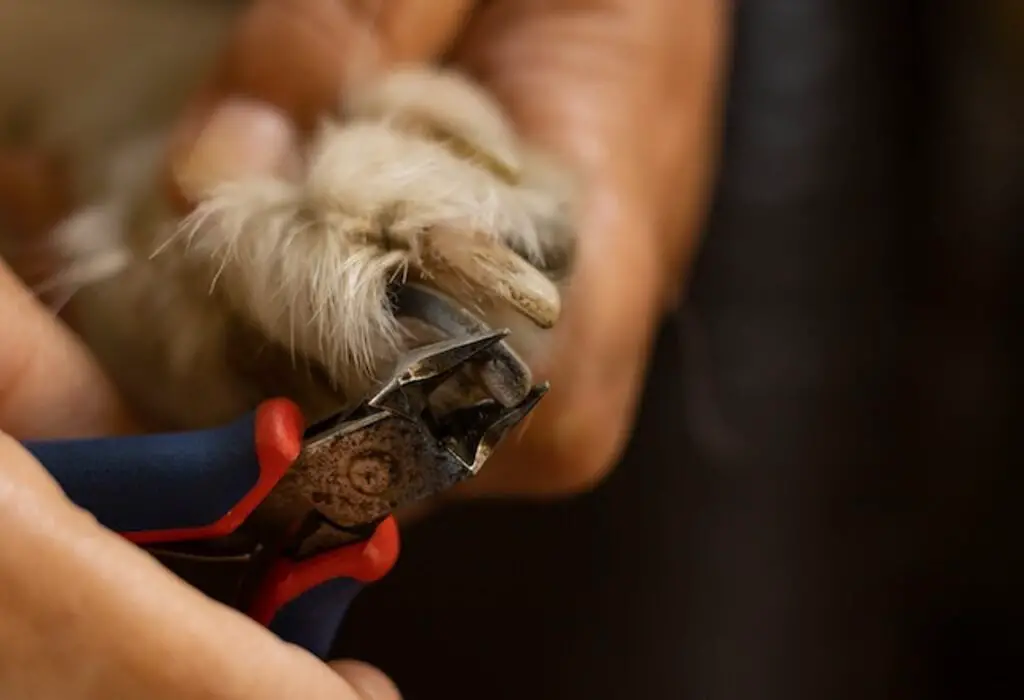Proper dog nail trimming is an essential part of keeping your furry friend healthy and comfortable. Long and overgrown nails can lead to pain, discomfort, and even infection.
As a responsible dog owner, it’s important to master the art of trimming your dog’s nails to ensure they stay well-groomed and healthy.
In this comprehensive guide, we’ll cover everything you need to know about dog nail trimming, including the tools you’ll need, step-by-step instructions, and tips to make the process easier for both you and your pup.
Whether you’re a seasoned pro or a first-time dog owner, our guide will provide you with all the essential information to keep your dog’s nails trimmed and healthy.
So, let’s get started and learn how to trim dog nails!
Key Takeaways
- Create a calm environment for nail trimming.
- Use proper dog nail clippers or grinders.
- Trim small portions at a time to avoid the quick (blood vessel).
- Reward your dog to make the experience positive.
- If unsure, consult a vet or professional groomer for guidance.

How to Trim Dog Nails
To trim dog nails, use sharp, guillotine-style or scissor clippers designed for pets. Gently hold the paw, trim just the tip, avoiding the quick (blood vessel). Reward your pup, and if unsure, consult a veterinarian or professional groomer. Regular trimming promotes paw health & avoids discomfort.
Why is Dog Nail Trimming Important?
Dog nail care is a crucial aspect of pet grooming. Keeping dog nails short is essential for maintaining their health and comfort. Overgrown nails can cause various problems, including discomfort, pain, and even deformities, which can lead to long-term issues. It is, therefore, crucial to trim your dog’s nails regularly to ensure their well-being.
Long nails can change the way a dog stands or walks, leading to posture problems and discomfort. Additionally, long nails may get caught in objects or surfaces, causing a split or tear, which is not only painful but can also lead to bleeding, swelling, or even infection. In some cases, long nails can cause the toes to splay, leading to joint problems and deformities.
Trimming your dog’s nails promotes comfort and good health. When the nails are short and well-groomed, there is less pressure on the toe joints. Short nails also prevent slipping and sliding on slick surfaces, which can cause accidents.
Regular dog nail trimming helps ensure that your pet stays healthy and happy for years to come.
Tools Needed for Dog Nail Trimming
Trimming your dog’s nails at home is a great way to save money and bond with your pet. However, to trim your dog’s nails effectively and safely, you will need to have certain tools on hand. Here are the essential tools you’ll need to get started:
| Nail Clippers | Choose a clipper that is suitable for your dog’s size and nail thickness. Scissor clippers and guillotine clippers are two common types. |
|---|---|
| Nail Grinder | A grinder can help you smooth rough edges after clipping. It can also be used as an alternative to clippers for dogs with dark nails. |
| Styptic Powder | This powder helps stop bleeding in case you accidentally cut the quick. It’s a must-have item for any pet owner. |
| Treats or Toys | Use treats or toys to distract and reward your dog during the trimming process. This can help keep them calm and make it a positive experience. |
While these are the essential tools, other optional items can also be helpful, such as a nail file, paw balm, or a grooming table. However, with just the above items, you’ll have everything you need to trim your dog’s nails safely and effectively at home.
Step-by-Step Guide to Trimming Dog Nails
Trimming your dog’s nails can seem daunting, but with the right tools and techniques, it can be a simple and stress-free process for both you and your furry friend. Follow these steps to trim your dog’s nails safely and effectively:
- Choose a quiet and well-lit area to trim your dog’s nails. Make sure your dog is calm and relaxed before starting.
- Hold your dog’s paw gently but firmly, and use your fingers to separate the toes. This will give you better access to the nail.
- Identify the quick, which is a pink area inside the nail that contains blood vessels and nerves. Avoid cutting the quick, as it can be painful and cause bleeding.
- Using sharp and appropriate nail clippers, cut the nail at a 45-degree angle, taking care to avoid the quick. If you are unsure where the quick is, trim just the very tip of the nail.
- If you accidentally cut the quick and it bleeds, use styptic powder to stop the bleeding. Apply the powder directly to the nail and hold it in place for a few seconds. If the bleeding persists, seek veterinary attention.
- Trim all the nails on the paw, including the dewclaw if your dog has one. Be sure to keep an eye on each nail as you trim, and stop if you see any signs of bleeding or discomfort.
- Repeat the process for each paw, taking breaks as needed to give your dog a chance to rest and relax.
- After trimming all the nails, reward your dog with plenty of praise, treats, or a favorite toy. This will help create a positive association with nail trimming and make future sessions easier.
By following these steps, you can confidently and safely trim your dog’s nails at home. Remember to always use proper tools, techniques, and care to ensure a comfortable and stress-free experience for your furry friend.

Tips for Easier Dog Nail Trimming
Trimming your dog’s nails can be a daunting task, but it doesn’t have to be a difficult or stressful experience for you or your furry friend. Here are some tips to make the process easier and more comfortable for everyone involved:
1. Get Your Dog Used to the Trimming Process
If your dog is nervous or resistant to nail trimming, start by allowing them to sniff and inspect the tools you will be using. Next, touch and handle their paws regularly, even when you’re not trimming their nails. This will help them become more comfortable with the process and reduce anxiety.
2. Choose the Right Time and Place
Select a time when your dog is relaxed and calm, such as after a walk or play session. Choose a well-lit area with a non-slip surface to prevent your dog from slipping or sliding during the nail trimming process.
3. Use High-Quality Nail Trimming Tools
Invest in high-quality nail trimming tools to ensure that the process is efficient and safe. Choose a sharp and appropriate size nail clipper or grinder (depending on your preference), and always have styptic powder on hand in case of any accidental cuts.
4. Practice Good Handling Techniques
When handling your dog’s paws, use a gentle but firm grip to prevent accidental movements that could cause discomfort. Support their paw with one hand and use the other to trim the nails.
5. Keep Treats Handy
Keep treats nearby to reward and distract your dog during the nail trimming process. This will help to keep them occupied and make the process more enjoyable.
6. Take Breaks If Necessary
If your dog becomes agitated or uncomfortable, take a break and resume the process later. This will prevent stress and make the experience more positive for both you and your furry friend.
Dealing with Overgrown and Dark Nails
Dogs with overgrown or dark nails require extra care during the trimming process, as it can be more difficult to distinguish the sensitive quick from the rest of the nail. If you are unsure where the quick is, it is better to trim a small amount of the nail at a time, rather than attempting to remove a large section at once.
Tip: It may be helpful to have styptic powder on hand in case you accidentally cut the quick, as this will help to stop any bleeding and prevent infection.
| Techniques for Overgrown Nails | Techniques for Dark Nails |
|---|---|
|
|
Tip: If your dog has dark nails, you can also try using a white nail polish or baby powder on the tip of the nail to provide contrast, making it easier to see the quick.
When to Seek Professional Help
If you are unsure about how to proceed with trimming your dog’s nails, or if your dog has particularly difficult nails, it may be best to seek the assistance of a professional groomer or veterinarian. They can provide guidance on the best techniques and tools to use, as well as helping to minimize discomfort for your dog.

What to Do If You Accidentally Cut the Quick
One of the most common concerns when trimming dog nails is accidentally cutting the sensitive quick inside the nail. This can cause bleeding and discomfort for the dog. If this happens, stay calm and follow these steps:
- Apply styptic powder: This powder helps to stop bleeding by clotting the blood. Dip the affected nail into the powder or apply it directly with a cotton swab.
- Apply pressure: Use a clean cloth or gauze to apply gentle pressure to the nail for a few minutes. This helps to encourage clotting and stop the bleeding.
- Use cornstarch as an alternative: If you don’t have styptic powder, you can use cornstarch as an alternative. The process is the same as with styptic powder – dip the affected nail or apply it with a cotton swab and apply gentle pressure with a cloth or gauze.
- Monitor the nail: Keep an eye on the affected nail and monitor for any signs of infection. If you notice any swelling, redness or discharge, contact your vet.
How Often Should You Trim Dog Nails?
Regular nail trimming is an essential aspect of dog grooming that helps keep your furry friend healthy, comfortable, and happy. The frequency at which you should trim your dog’s nails depends on various factors, including the breed, size, and activity level.
Dogs that live an active lifestyle and spend more time outside on rough surfaces may require less frequent nail trimming, as their nails are naturally worn down. However, indoor dogs or those with slower growth rates may need more frequent trimming to keep their nails at a safe and comfortable length.
| Breed | Frequency |
|---|---|
| Small breeds (e.g., Chihuahuas, Yorkies) | Every 4-6 weeks |
| Medium breeds (e.g., Bulldogs, Boxers) | Every 4-8 weeks |
| Large breeds (e.g., Labrador Retrievers, Golden Retrievers) | Every 6-8 weeks |
| Giant breeds (e.g., Great Danes, Saint Bernards) | Every 8-12 weeks |
Keep in mind that the above frequencies are general guidelines, and you should always monitor your dog’s nails and make adjustments to the frequency as needed. If you’re unsure about how often to trim your dog’s nails, consult your vet or a professional groomer for guidance.
Alternatives to Traditional Nail Trimming
While regular dog nail trimming is essential, it’s not the only way to keep your furry friend’s nails in good shape. Here are some alternative methods you may want to consider:
| Method | Description |
|---|---|
| Walks on abrasive surfaces | Regular walks on concrete, asphalt, or other rough surfaces can help wear down your dog’s nails naturally. However, it’s important to monitor your dog’s nails to ensure they don’t become too long. |
| Scratching posts | Scratching posts provide cats with a natural way to keep their nails trimmed, and some dogs may benefit from them as well. Be sure to choose a post made of rough material and encourage your dog to use it regularly. |
| Cover material | Special cover materials, such as SoftPaws and Nail Caps, can be placed over your dog’s nails to protect them from wear and tear. These materials come in various sizes and colors and are applied using an adhesive. |
While these alternative methods can help keep your dog’s nails in good condition, they should not be relied upon solely. Regular dog nail trimming is still the best way to ensure your pet’s nails remain healthy and comfortable.
Signs of Nail Problems in Dogs
Proper nail care is essential for a dog’s health and well-being, but sometimes nail problems can arise despite our best efforts. Here are some common signs that your dog may be experiencing nail problems:
| Signs | Description |
|---|---|
| Overgrown nails | If you notice that your dog’s nails are excessively long or are curling under, it may be a sign that they are not being trimmed often enough. |
| Limping or favoring a paw | If your dog is suddenly limping or seems to be favoring one paw, it may be due to a nail problem such as an ingrown nail or an infection. |
| Bleeding or swelling around the nail | If you notice any bleeding or swelling around the base of the nail, it could be a sign of infection or injury. |
| Licking or chewing at the paws | If your dog is constantly licking or chewing at their paws, it may be a sign of discomfort or pain caused by a nail problem. |
If you notice any of these signs, it’s important to consult with your veterinarian to determine the underlying cause and receive appropriate treatment. In some cases, your dog may require medication or even surgery to address the issue.

Tips for Nervous or Resistant Dogs
Some dogs may become nervous or resistant during nail trimming sessions, making the process more challenging for their owners. However, there are several strategies and techniques that can help create a calm and positive environment, making the experience more comfortable for both the dog and the owner.
1. Introduce Nail Trimming Gradually
If your dog is particularly nervous or resistant to nail trimming, it may be helpful to introduce the process gradually. Start by simply touching your dog’s paws and rewarding them with treats.
Gradually increase the amount of time you spend touching their paws, until they are comfortable with handling. Then, introduce the nail clipper or grinder slowly, rewarding your dog for positive behavior.
2. Use Positive Reinforcement
Positive reinforcement can be an effective tool for encouraging good behavior during nail trimming sessions. Reward your dog with treats or praise when they exhibit calm, cooperative behavior. This can help make the process more enjoyable and less stressful for your dog.
3. Consider Professional Grooming
If your dog is particularly anxious or resistant to nail trimming, it may be worth considering professional grooming services. Professional groomers have experience working with all types of dogs, and can often complete the process quickly and effectively.
4. Try Distraction Techniques
Sometimes, distraction techniques can be helpful for keeping dogs calm during nail trimming. Consider providing your dog with a special treat or toy that they only get during nail trimming sessions. Alternatively, playing calming music or providing a comforting touch can help keep your dog’s attention focused elsewhere.
Overall, with patience and practice, it’s possible to help even the most nervous or resistant dog become comfortable with nail trimming. By introducing the process gradually, providing positive reinforcement, and utilizing distraction techniques, you can help ensure a more comfortable and stress-free experience for your furry friend.
Frequently Asked Questions (FAQs)
Here are some common questions and concerns about dog nail trimming:
1. How often should I trim my dog’s nails?
The frequency of nail trimming varies depending on the dog’s breed, size, and activity level. In general, it is recommended to trim your dog’s nails every 2-4 weeks.
2. Can I use human nail clippers to trim my dog’s nails?
No, you should use specialized dog nail clippers or grinders. Human nail clippers may cause discomfort, and their blades may not be strong enough to handle a dog’s thicker nails.
3. What if my dog’s nails are too dark to see the quick?
If you cannot see the quick inside the nail, it’s best to trim a small amount at a time until you see a black dot in the center of the freshly cut nail. This dot is the end of the quick, and you should stop trimming at this point to avoid cutting it.
4. What should I do if I accidentally cut the quick?
If you accidentally cut the quick and the nail begins to bleed, use styptic powder or cornstarch to stop the bleeding. Hold a small amount onto the nail for a few minutes until the bleeding stops. If bleeding persists, contact your veterinarian.
5. How can I make my dog more comfortable during nail trimming?
You can make your dog more comfortable during nail trimming by providing treats, positive reinforcement, and a calm environment. You can also try desensitizing your dog to the nail trimming process by touching their paws and nails regularly and gradually increasing the duration of interactions.
6. When should I seek veterinary care for my dog’s nails?
If your dog’s nails are excessively overgrown, brittle, or discolored, it may indicate an underlying health issue. Additionally, if your dog exhibits signs of pain or discomfort during nail trimming, such as yelping or biting, it’s best to seek veterinary care to rule out any medical conditions.


